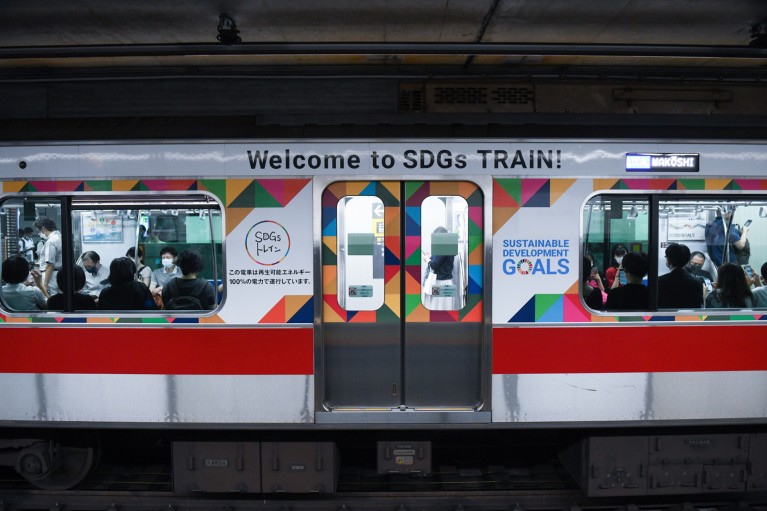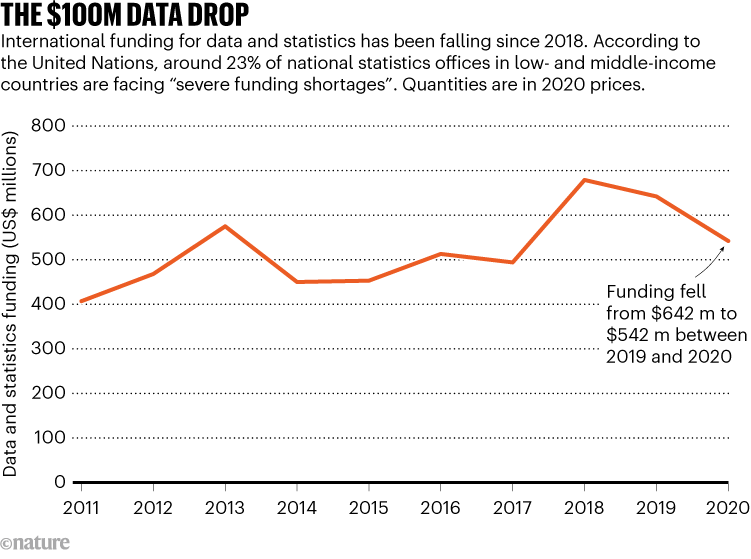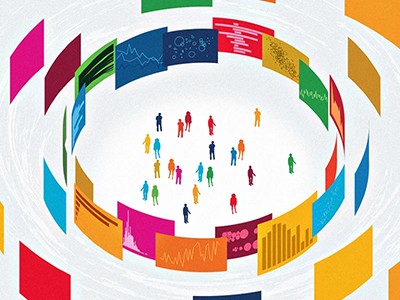
The United Nations’ SDGs have transcended the policy world and entered the public consciousness.Credit: Noriko Hayashi/New York Times/Redux/eyevine
When a well-thought-out plan isn’t succeeding, what should the response be? Abandon the plan entirely? Hope that it just needs more time to work? Or get to grips with why it’s not working and make changes accordingly?
In the case of the United Nations’ Sustainable Development Goals (SDGs), giving up cannot be an option. However, this global plan to end poverty and achieve environmental sustainability is clearly not working. None of the 17 goals, which include combating climate change and reducing inequality, is expected to be achieved by the UN’s 2030 deadline. Only about 12% of the 169 underlying targets are likely to be met. For example, 2.2 billion people around the world lack access to safe drinking water and more than 300 million people go to bed hungry every night. The stated aim of the SDGs is to drive both numbers to zero.

Extending the Sustainable Development Goals to 2050 — a road map
Is it possible to improve on the existing approach? In a Comment article this week, a group of researchers from institutions in Europe and the United States suggest a combination of responses. The researchers propose that the 17 goals should all remain the same, as should many of the targets and indicators for those targets. But they are also calling for greater ambition. The goal to end poverty should include providing social protection for vulnerable people, for example. The goal for zero hunger should also tackle undernutrition.
In other cases, they suggest that actions should align with international agreements — such as the Paris climate agreement’s commitment to achieve net-zero emissions by 2050, so that global temperatures do not exceed 1.5 °C above pre-industrial levels.
There are other lessons to be learnt since the SDGs were first agreed in 2015, such as the potential impacts of artificial intelligence (AI), the authors say. One study finds that AI could benefit 134 targets across all the goals, such as making better weather forecasts or improving medical diagnoses, but that AI could also inhibit 59 targets by, for example, fuelling the spread of disinformation (R. Vinuesa et al. Nature Commun. 11, 233; 2020).
Their advice is well timed. Talks on a post-2030 future for the SDGs have not yet officially begun, but because adjustments to them cannot be made quickly, the earlier that discussions can begin, the better. Any new indicator would need to meet the UN Statistical Commission’s criteria of being conceptually clear and having an internationally established methodology and agreed standards. All relevant data, moreover, would need to be regularly produced by a large proportion of countries.
Shortly after the SDGs were settled, only around 60% of the indicators had an agreed methodology and standards. Achieving this for the remaining indicators took four years. At the latest tally (in 2022), data are still not being produced by all countries for one-third of the indicators, often because of a lack of funding or because of other constraints (see ‘The $100m data drop’).

Source: UN/PARIS21
For these and other reasons, some of the goals are still not being assessed using quantitative measures. The standout example is SDG 13, the goal for climate action, which lacks a measurable target for reducing greenhouse-gas emissions. To be part of the SDGs, national emissions would be reported annually and to a standard to be defined by expert bodies and then agreed by all member states — as would all other newly proposed targets and indicators.
Collaborate, collaborate
Table of Contents
There’s a second reason why this proposal is well timed. UN secretary-general António Guterres has invited representatives of world leaders to gather in New York City this September for a meeting called the Summit of the Future. A draft of the document to be agreed on at this event — called the Pact for the Future — refers to a proposal to identify 10–20 SDG-like indicators of economic growth, well-being and sustainability. Few of the SDGs have the priority, status and attention in national policymaking that SDG 8 (economic growth) does. Guterres wants to change this and get policymakers to focus not just on economic indicators such as gross domestic product (GDP), but on a dashboard of indicators that he is calling Beyond GDP.

The world’s goals to save humanity are hugely ambitious — but they are still the best option
It’s important that this idea does not compete with the SDGs. That would be unproductive, given that both have similar aims. It is not surprising that this has happened — the UN is a large organization that is both complex and highly siloed. But with the opening of a debate about how best to iterate the SDGs, there is now an opportunity to allow these two processes to converge.
The SDGs ought to “remain at the centre of global policy agendas”, as the authors of the Comment article argue. The international community would then choose its favoured 10–20 indicators from any updated list. A huge amount of work has gone into creating and refining the SDGs. Guterres’s parallel effort will benefit by linking to the SDGs, taking advantage of almost a decade of accumulated learning, rather than trying to reinvent the wheel.
A big win of the SDGs is that they have transcended the world of policymakers. Their multicoloured logos can be found everywhere from classrooms to company websites. They took a long time to negotiate, and a much has gone into their refinement. Any future efforts must build on what the world has learnt — while not losing the sense of urgency that comes with the existing deadline.
